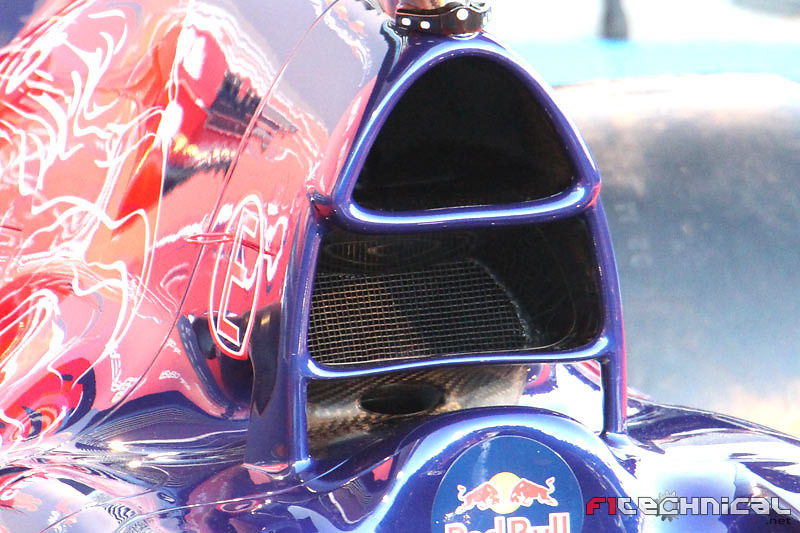Toro Rosso STR9 launch analysis
The car is effectively also the first Renault powered car to be launched as Red Bull, Caterham and Lotus have yet to show their hand.
Like most other teams, Toro Rosso came up with a finger nose, but seemingly the highest one seen so far. While the monocoque itself does show a slight slope towards the front bulkhead, the nose itself then again is fairly flat up until the point where the front wing supports are mounted. What's ahead is just a 10cm by 10cm extension to match the regulations.
The design is fairly interesting and keeps some resemblance to the Toro Rosso STR8 with the upside of the nose being rather flat and wide. Of course, underneath, certainly at the front, is a bulge in the middle that is part of the crash structure.
The front wing on the launched car does appear fairly similar to one raced last year, so it is likely the team have gone conservative and will try to get an aero benchmark in while the guys at the factory are busy optimising the design. The design of the front wing endplates has often been pinpointed as a crucial area in 2014, even when the total width of the front wing has only reduced by 15cm.
Next up for the airflow are the sidepods, which maintain cooling apertures similar in size as on the 2013 car. The bargeboard and sidepod panel are straightforward and uncomplicated, unlike the Ferrari and Sauber designs.
What is interesting however is the airbox treatment. As the team have retained smallish sidepod inlets to enhance airflow to the low rear of the car, the airbox itself now features a very large inlet. In fact, rather than undercutting like Sauber does, the team simply put a large cooling hole underneath the normal airbox.

The upper inlet appears to go towards the rear of the engine, suggesting that this is indeed the regular airbox, now designed to catch air to feed the turbo. The larger opening underneath features a grill to prevent debris entering the channel. It also appears to go downward, possibly blowing an oil cooler that sits above the engine. McLaren have done something similar in the past, so it certainly is not unthinkable. Below that is a small undercut which also features a smaller, oval cooling aperture.
The sidepods themselves taper down to the rear end differently than on the McLaren or the Sauber for instance, as Toro Rosso have apparently not cared too much about the undercut of the sidepods. Instead, the car features fairly wide shoulders and sidepods that slope down quickly. It does make the car look more sleek without any bulges and bumps, but it still is fairly wide. The advantage of this approach is the possibility of having components closer to the floor of the car, benefiting the overall centre of gravity.
The rear wing area is also different to designs seen before, as Toro Rosso have created a rear wing without central pillars, instead extending the endplates down onto the floor and diffuser. This does create a little bit less disruption of airflow through the middle of the rear wing, but will only be beneficial if the endplate extensions do not work against the efficiency of the diffuser. The team does appear to have thought it through though as the front end of that rear wing endplate gradually extends forward to make for a very long joint with the floor. It is unclear if this is for aerodynamic reasons or if this was needed to create sufficient bending resistance in the rear wing.
The endplates themselves are nothing spectacular but they do feature a tyre squirt gap, a rear end gurney flap that widens towards the floor and that has vertical slits attached to it to help the diffuser's airflow expansion.
What is present on the car however is a maximum width, two element monkey seat, supported by winglets located on each side of the rear crash structure, a little lower than where the beam wing used to be. The upper panels are curved to create a diffuser effect on the exhaust. The high speed exhaust gases will speed up airflow underneath the monkey seat, reduce pressure and increase downforce. Essentially a win win situation that is most likely to be seen at various other cars as well. Also note the curve on the upper side of the rear crash structure, continuing the shape of the underside of the circular exhaust pipe.
Finally, even though the diffuser itself was mainly covered at the launch, the central piece of the floor just ahead of the diffuser features an interesting curve, locally mimicking a double deck diffuser that benefits from the upward curve of the rear crash structure. How exactly that works is unsure at the moment, but it would appear like air from within the sidepod - either from the radiators or directly from one of the cooling inlets - feeds this opening to create a small downforce benefit.

The car obviously hits the track tomorrow, so more pictures will probably reveal more detail, including perhaps signs of reliability and speed, or a lack thereof.



